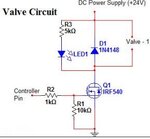jai patel
Newbie level 3

Hello Everyone,
I am using PIC16F887, MOSFET IRF540n and 24V power supply and using this I have design a switching circuit as below.

here I am using 24V power supply and solenoid valve which need 24V to start and 5kohm of resistor in series with LED to show that switch is ON and OFF. and it works fine.
Now if I want to design circuit for 12V valve then how I calculate resistor value in series with LED.
and if I want to use only single circuit for either 12V or 24V power supply then can I?
I am using PIC16F887, MOSFET IRF540n and 24V power supply and using this I have design a switching circuit as below.

here I am using 24V power supply and solenoid valve which need 24V to start and 5kohm of resistor in series with LED to show that switch is ON and OFF. and it works fine.
Now if I want to design circuit for 12V valve then how I calculate resistor value in series with LED.
and if I want to use only single circuit for either 12V or 24V power supply then can I?




